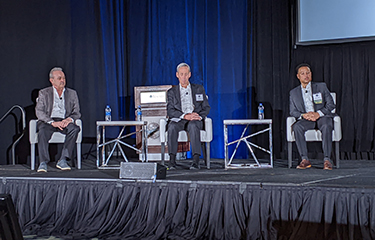As China’s economy continues to evolve and its trade relationship with the U.S. remains strained, it is likely other countries in Southeast Asia will take a larger role in processing seafood, according to a panel of experts at the National Fisheries Institute’s Global Seafood Market Conference.
Trade relations between the U.S. and China became suddenly more volatile when the administration of U.S. President Donald Trump implemented tariffs on Chinese goods. Trump's stated goal was to put an end to the significant trade imbalance between the two countries – an imbalance that U.S.-China Business Council President Craig Allen said was nothing new.
“The U.S. has had a trade deficit with China going back to the formation of our country, going back go to the 1780s when we exported a little bit of seafood and imported a whole lot of tea. That trade deficit lasted for literally hundreds of years.” Allen said. “There was, during the Trump era, a rebellion against what had become a standard, very large trade imbalance.”
The back-and-forth negotiations and a tit-for-tat tariff rate escalation eventually ended with the “Phase One” agreement between the U.S. and China, which Allen said could be “potentially very important for the seafood industry, including for those of you who look at China as a market, for those of you who look at China as processing hub, and for those of you who look at China as a source.”
The Phase One agreement included some commitments by China to buy a certain amount of U.S.-produced seafood – commitments that so far experts say China has failed to meet. Regardless of the agreement and whether it's being adhered to, Allen said that the bilateral trading relationship isn’t going to smooth out anytime soon.
“How to get out of the trade tension? I don’t see a clear pathway right now. I wish I could provide you with a roadmap. But at least for 2022, I expect very stormy seas,” Allen said.
In addition to tariffs on Chinese goods and a rocky trade relationship, changing demographics within China are also influencing the cost of processing in China as the labor market tightens, Allen said.
“The birth rate this year is the lowest that it’s ever been, and rural-to-urban migration is basically finished,” he said. “China is now 70 percent urbanized, so the labor prices are going to continue to rise, probably quite rapidly.”
That has led to companies seeking another place to process goods – mainly in Southeast Asia, Allen said.
“The fundamental question [for] a lot of businesses large and small – many of them members of both the U.S.-China Business Council and U.S.-ASEAN Business Council – is, in an evolving supply-chain environment, are there commercially competitive alternatives to China for either sourcing [or] processing?” U.S.-ASEAN Business Council Senior Vice President-Policy Marc Mealy said.
Mealy said numerous countries in the Southeast-Asia region are jumping at the chance to attract American businesses to establish new processing enterprises. Top seafood producing countries like Indonesia, Thailand, Vietnam, and the Philippines are all looking to keep some of that production at home and are appealing to foreign investment.
“They’ve got governments who really are waving their hands saying ‘Hey, American businesspeople, take a look at us,’” Mealy said.
Vietnam specifically has done well to position itself as a competitive alternative to China, Mealy said. And across the region, there has been significant cooperation between the U.S. government and governments in Southeast Asia to enhance the sustainable production of seafood in the region, he said.
However, a major obstacle to businesses transitioning their processing out of China is the significant amount of expertise Chinese processors have accrued through decades of serving as the world's leading seafood-processing hub.
“You have these centers in places like Qingdao and Dalian that have really built significant expertise,” Reis Consulting Principal Judson Reis said. “There’s remarkable skill in terms of their ability to maximize the yield.”
Even though the processing skill-level in China is high, Mealy said that a lot of effort is being made in Southeast Asia to build up domestic expertise.
“Not only are these economies getting better at what they do, but they’re also cooperating across their respective industries,” Mealy said. “There are two regional seafood industry organizations in Southeast Asia that are again trying to help build capabilities and help producers move up the value chain within Southeast Asia.”
An option to make the transition easier, Allen said, is to have existing Chinese partners aid the move.
“This is not a binary thing, leaving China and then going to a brand-new country where you don’t know anybody,” Allen said. “You can leave China and go with your partners to another country and bring their expertise and some of their processing technology with them to mitigate both your risks.”
The ideal partner, Reis said, is a country that is politically stable, has some existing capacity, and that is supportive of a business-to-business environment. Another key metric is whether a company that already manufactures similar products has already set up shop, whether for export or the domestic market, Mealy said.
A complicating factor, however, is whether global shipping rates will return to being less expensive than they are currently. Long supply chains and “just-in-time” inventory have worked well when the supply chain was robust pre-pandemic, but U.S. ports have struggled recently to handle increased volumes and shipping costs have spiked.
“If you think about what has made global supply chains so effective, shipping was really a very, very modest percentage of goods over time [and] container shipping was very efficient across the globe,” Reis said. “If that changes, if that becomes more expensive, that’s another factor you have to include in there.”
Photo by Chris Chase/SeafoodSource







